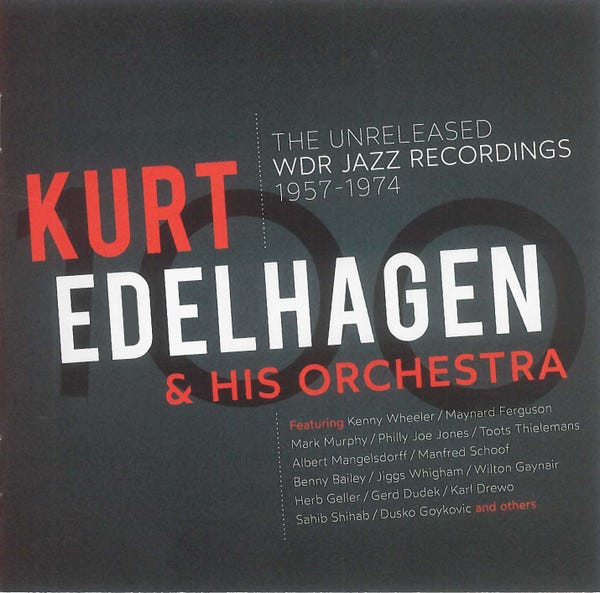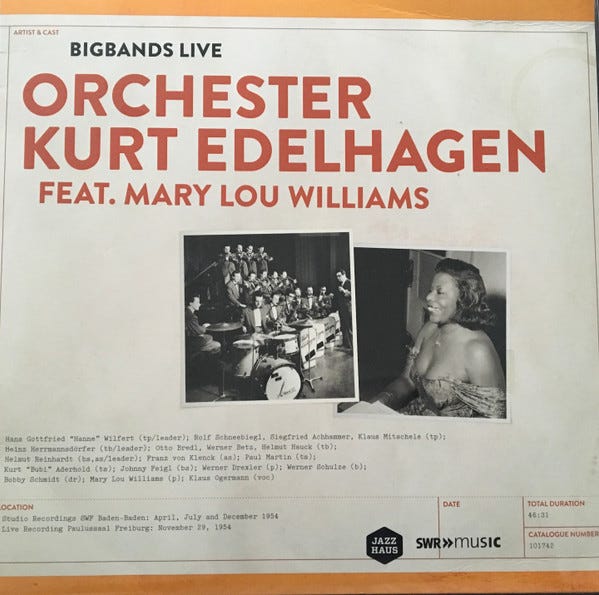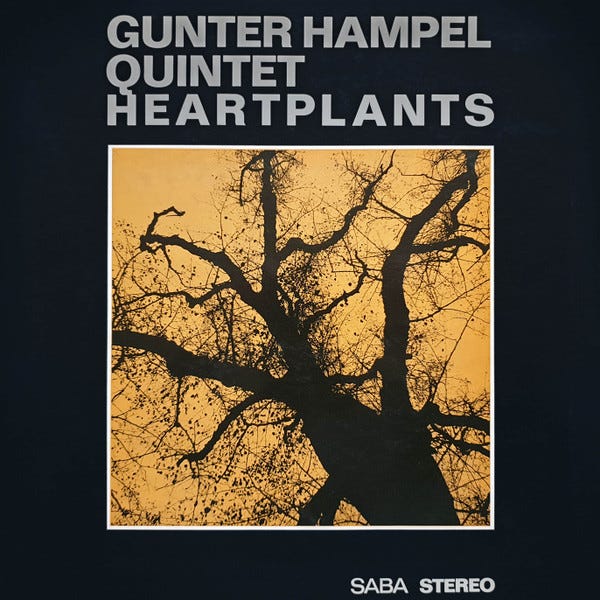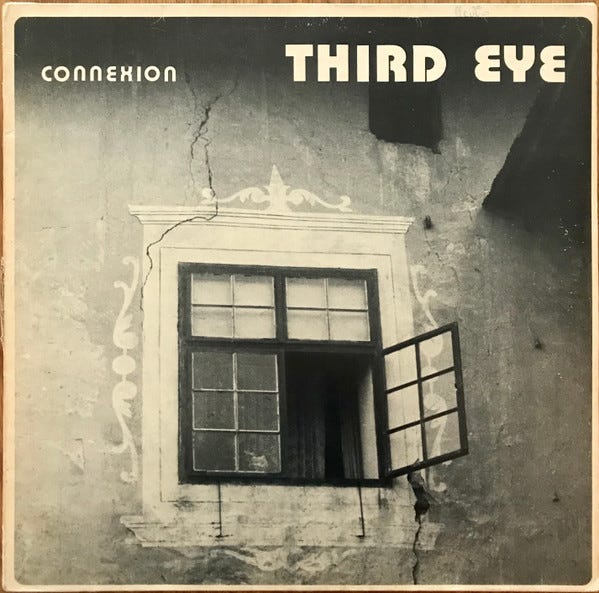I first heard Herb Geller play on the Chet Baker album The Trumpet Artistry of Chet Baker, released in 1953 on the Pacific Jazz label. Geller was a native of the LA jazz scene and married a local piano player named Lorraine Walsh, the house pianist at Lighthouse Jazz Club:
She was part of Contemporary Records’ historic album At Last recorded on September 13, 1953, Max Roach's first show with the Lighthouse All-Stars with Chet Baker and Miles Davis.
Tragically, Lorraine died of an acute asthma attack in 1958. Deeply depressed, Herb Geller left LA to tour through Brazil with the Benny Goodman Orchestra. He ended up staying in São Paulo for six weeks playing bossa nova music at a local club and then boarded a ship bound for Europe.
He played around in Paris and eventually found his way to Germany and Kurt Edelhagen’s Orchestra, where on April 2, 1964, at WDR’s (Westdeutscher Rundfunk) Studio 1 in Köln he recorded a song he wrote and arranged called A Cool Day (Bled and Butter):
Geller takes the first alto sax solo.
This recording remained unreleased until 2021 when the Jazzline Classics label released it on their compilation album Kurt Edelhagen & His Orchestra: The Unreleased WDR Jazz Recordings 1957-1974.
I’m not sure about the circumstances surrounding Geller’s playing with Edelhagen but he was one of many great musicians worldwide to join and record with Edelhagen’s Orchestra.
This week on that Big River called Jazz we dig in our paddles to explore the world of a few great musicians in Kurt Edelhagen’s Orchestra in post-war Germany.
Kurt Edelhagen was born in 1920 in Herne, a town in the North Rhine-Westphalia area of Germany. He discovered jazz during WWII. After the war along with his friend drummer Bobby Schmidt, he formed a big band that played in clubs for Allied Armed Forces and German audiences.
Although the presence of US troops at the end of WWII played a large part in the formation of jazz big bands throughout Europe, in Germany the existence and support of regional radio and TV orchestras played a more important role. For example, Kurt Edelhagen’s longtime relationship with WDR in Köln helped build what the leading authority on German Jazz Joachim Berendt claimed was “the German response to the American challenge posed by (Stan) Kenton.”
Edelhagen’s big break came in March 1954 when his band played on a weekly TV series “Jazz Time Baden-Baden” produced by Berendt. During a November program, Edelhagen’s Orchestra performed a concert with performances by American pianist and composer Mary Lou Williams. The recording was released in 2013 on the Jazz Haus label:
It’s not clear how Williams’s participation in these Freiburg, West Germany sessions came about except that two years earlier she had traveled to England and decided to remain in Europe for a while.
An important part of Williams’s performance with Edelhagen’s Orchestra was it paved the way for more international musicians to join his band, beginning with the American bassist Jimmy Woode.
Woode joined the Duke Ellington Orchestra in 1955 and remained with him until 1960 when he left to live in Europe. In September and November 1961, he recorded with Eric Dolphy in Stockholm and in December joined Edelhagen’s Orchestra. Here is Woode featured on Black Velvet, a tune arranged by Belgian pianist and composer Francy Boland:
The song also features a nice alto solo by British saxophonist Derek Humble, who had been with Edelhagen’s band since 1957. Humble is a musician deserving wider recognition. Here he is playing the Dizzy Gillespie and Charlie Parker tune Shaw ‘Nuff:
Francy Boland gained recognition starting in 1949 while playing with fellow Belgian Bobby Jasper. Both joined Chet Baker’s quintet in 1955, which resulted in this album released by the French Barclay label in 1956:
Soon after this recording Boland moved to the US and started arranging for Count Basie, Benny Goodman, and Woody Herman. He set up an octet with Kenny Clarke before returning to Europe to join Edelhagen’s Orchestra as chief arranger in the late 1950s.
Although Boland left Edelhagen in 1961 to form the Kenny Clarke-Francy Boland Big Band, his connection with Clarke helped Edelhagen recruit other fine American musicians like Woode and Sahib Shihab, who is featured above on baritone sax on Bohemia After Dark.
In 1961, at seventeen years old Ohio-born trombonist Jiggs Whigham joined Glenn Miller’s band and two years later moved to Stan Kenton’s mellophonium band. However, frustrated with the American jazz scene, in 1966 he left for Germany and found work in Edelhagen’s Orchestra. Here’s Whigham playing the song Edelhagen named after him - Oliver Hayden Whigham III:
Jamaican Wilton Gaynair, an alumnus of the Alpha Boys School in Kingston, joined Edelhagen’s Orchestra in 1964.
Gaynair moved to Europe in the mid-1950s and decided to stay in Germany, where he remained for the rest of his life. He seldom recorded, only three times as a bandleader. One of those recordings, Blue Bogey, came during a return visit to England in 1959. It was released on Tempo Records, an interesting British label specializing in jazz and blues records. Incidentally, Tempo Records released Alexis Korner's Skiffle Group in 1957, Korner’s first album.
Ellsworth McGranahan “Shake” Keane arrived in England in 1952 from his native St. Vincent to study English literature. However, while working for the BBC he interviewed Jamaican saxophonist Joe Harriott, and this chance meeting moved him in a new direction. In 1960 he joined Harriott’s quintet and recorded on Harriott’s Free Form (1961), Abstract (1963), and Movement (1964) albums. Ellsworth acquired his nickname because poetry was equally important as jazz - Shake is short for Shakespeare. In 1965, looking for more stable work, Keane moved to Germany and joined Edelhagen’s Orchestra. With the addition of Shake Keane, Edelhagen’s Orchestra now featured two important Caribbean musicians.
Here is KE, an awesome song featuring the whole gang with solos by Gaynair, Keane, Whigham, and Humble:
Here are two nice live performances by Keane and Gaynair at a Berlin concert in 1966. The first features Keane on Roy:
…and the second features Gaynair on You Shouldn’t:
Another Edelhagen disciple was German trumpet player Manfred Schoof, who took classes from Edelhagen while studying at the Köln Musikhochschule. Schoof contributed to several songs for Edelhagen’s Radio Big Band show. Incidentally, in 1965 while still working with Edelhagen, Schoof toured with Gunter Hampel and recorded on his seminal Heartplants, released on the German SABA label:
I wrote about Hampel here:
In the late 1960s, Edelhagen’s Orchestra even embraced some of the more improvisational or experimental music hitting the scene in Germany, led by among others Schoof, Albert Mangelsdorf, and Peter Brötzmann. Here is Triple Adventure featuring solos by Mangelsdorf and Schoof:
During the 1970s the Edelhagen Big Band continued to record and tour; however, these were difficult times for jazz in Europe. According to Whigham:
After 1968 the traditional big bands faced difficult times, mostly caused by the rise of rock music. Edelhagen tried to get into the market for commercial music as a competitor to Max Greger and other dance bands. This worked to some extent and there were some good times. Nevertheless, the band split up in December 31, 1972. On this day we received our notices from WDR and Kurt. I never fully understood the true story behind this development.
Here’s an example of his band trying to stay relevant in 1972:
The 1972 Summer Olympics opened in Munich, West Germany on August 26, 1972. Interestingly, Kurt Edelhagen’s Orchestra was given the honor to write and perform the music for the Olympic Parade. Here’s the album released from that performance:
Here’s a complete video of the 1972 Parade of Nations in Munich’s Olympic stadium:
This video is interesting in its own right, and the overall seriousness of the teams is in some cases striking. The dated outfits the athletes are sporting, like the Bermuda team’s strange hats and yellow shorts (7:00 minute mark), the Bolivian team’s oddly similar Nazi salutes at the “eyes right” point of the march (7:46 minute mark), and the East German team’s general cheeriness makes the Parade of Nations interesting watching. Kurt Edelhagen’s Orchestra is playing the music live in the stadium and at the very end you can see him conducting.
We may remember the 1972 Olympics for U.S. swimmer Mark Spitz’s winning an incredible seven gold medals while breaking seven world records or for the game’s media star Soviet gymnast Olga Korbut; however, the Munich Games are most remembered for the hostages.
On September 5th, eight Palestinian terrorists, representing the militant group "Black September”, broke into the Olympic Village, killing two members of the Israeli team and taking nine hostages. In the ensuing battle, all nine Israeli hostages were killed, as were five of the terrorists and one policeman. The games were suspended for 34 hours, and a mass was held in the main stadium to commemorate the victims. In defiance of the terrorists IOC President Avery Brundage famously said, "The Games must go on!" And they did. However, the Edelhagen Orchestra’s Olympic performance marked the beginning of the end.
Here’s one more for the road. After Edelhagen’s Orchestra folded in 1974, alumni Kenny Wheeler, Gerd Dudek, and Wilton Gaynair helped co-founded the group Third Eye, which recorded on Ring Records, a German jazz label founded in 1974 by Burkhard Hennen.
In August 1977, at Procom Studio in Kirchhellen, Germany, Third Eye recorded Connexion, with Gaynair contributing three of the album’s four compositions:
From the album, here is Ogetnom:
The Kurt Edelhagen Orchestra was top-notch. On September 7, 1969, at the battle of the bands at Sartory-Hall in Köln, his band won first prize, beating out both the Thad Jones/Mel Lewis and the Kenny Clarke/Francy Boland Big Bands. Jazzline Classics’ compilation album Kurt Edlehagen & His Orchestra: The Unreleased WDR Jazz Recordings 1957-1974 is an important document and a testament to the high quality of the musicianship in this important European big band.
It was discipline and precision that distinguished the work of Kurt Edelhagen. He passed away in Köln in 1982 but left an important jazz legacy in post-war Germany that should not be overlooked nor forgotten.
Next week on that Big River called Jazz, we’ll dig our paddles into the waters of Detroit organist Lyman Woodard.
Please hit this link to buy me a cup of coffee, if you’d like to show your guide some appreciation for this and past journeys. Know in advance that I thank you for your kindness and support.
If you like what you’ve been reading and hearing so far on our journey and would like to share this with someone you think might be interested in learning more about our great American art form: Jazz, just hit the “Share” button.
From Astaire to Sun Ra: A Jazz Journey is a reader-supported publication. If you feel so inclined, subscribe to my journey by hitting the “Subscribe now” button.
Feel free to contact me at any time to talk shop. I welcome and encourage that.
Until then, keep on walking….













thanks for a post full of interesting things - even that '72 performance of Edelhagen trying to stay 'relevant' is, in my opinion, way better than other similar things of that era heard from Buddy Rich or Maynard Ferguson. Edelhagen is the real thing. When I have more time I intend to go through all those recordings, and I am glad to read about Herb Geller, who I knew only casually but who was one of the kindest people I ever met in the business as well as a great saxophonist.